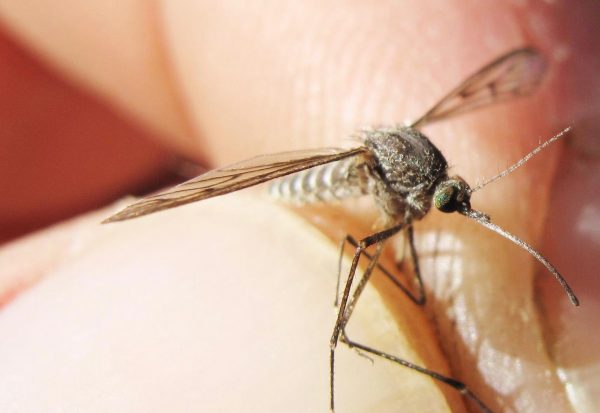It’s time for Alaska’s mosquitoes to shine
July 2, 2018
Ned Rozell
907-474-7468

Here are some tips to avoid mosquitoes this summer: First, wear light-colored clothing. Second, bathe more often in an attempt to be as odorless as possible. Third, avoid exhaling while in the woods.
"Snow mosquitoes," the big, sluggish mosquitoes that were the first to emerge, survived the winter by bundling up in leaf litter or wedging themselves under loose tree bark. Like many hibernating insects, overwintering mosquitoes depend on supercooling, a process by which an animal has the ability to rid its body fluids of impurities that would trigger the formation of ice. Supercooling allows the mosquito to cool down below 32 degrees Fahrenheit without its cell walls bursting.
Mosquitoes in hibernation can survive temperatures down to about 25 below zero. But years with a meager snowpack may cause quite a few mosquitoes to freeze and die during frigid weather. Yellowjackets, also supercoolers, may take quite a hit in low snow years.
But a lack of snow doesn’t harm the eggs of mosquitoes. Those eggs are the source of the smaller, faster mosquito species that hatch later in the summer.
Mosquito eggs laid in the fall float atop standing bodies of water ranging in size from Wonder Lake to a water-filled moose track in the tundra. Dozens of species of mosquitoes hatch from these eggs, spread all over Alaska.
Only female mosquitoes bother us. Females need blood's protein to develop their ovaries and make more mosquitoes. Males survive by sipping nectar from flowers and sucking juices from fruit; females also supplement their diet with nectar. While both males and females have antennae, the males' are much more garish, protruding like large feathers. The males' antennae act as tuning forks, resonating to the whine produced by the wings of females. During mating season, a few to a few thousand males gather together in swarms. Males in the cloud seize any female that wanders inside. Like dragonflies, mosquitoes mate in mid-air.
Once fertilized by the male, the female mosquito searches for a blood donor. Using sensors on its antennae, a mosquito picks up animals' body odor and carbon dioxide (a gas we exhale, along with water vapor). The female mosquito follows the trail upwind to its source. Once mosquitoes get closer, they're attracted to other cues such as dark colors, moisture in the air and silhouettes of potential victims.
Researchers found that mosquitoes responded to the cues of a calf dairy cow when it was standing 45 feet away, as a writer reported in the British text, "The Biology of Mosquitoes." Insect repellents are designed to block mosquitoes' sensory organs with heavy, bulky molecules. When its sensors are clogged with repellent, a mosquito is fooled into looking elsewhere for its blood meal.
Mosquitoes may not prefer human blood. In the 1949 book, "The Natural History of Mosquitoes," researcher Marston Bates reported that one species of mosquito laid half as many eggs after feeding on man than it did after digesting the blood of rabbits, guinea pigs and rats.
Bates reported on another experiment where mosquitoes were released in a room containing humans, pets and livestock. Factoring in the size difference of each animal, cows were the mosquitoes' favorite target, with 47.6 percent of the bites. Goats followed at 25 percent, then pigs at 13.8, humans at 4.8, dogs at 3.6, cats at 3.4 and barnyard fowl at 1.8 percent.
Since the late 1970s, the University of Alaska Fairbanks' Geophysical Institute has provided this column free in cooperation with the UAF research community. Ned Rozell is a science writer for the Geophysical Institute. A version of this column ran in 1996.


